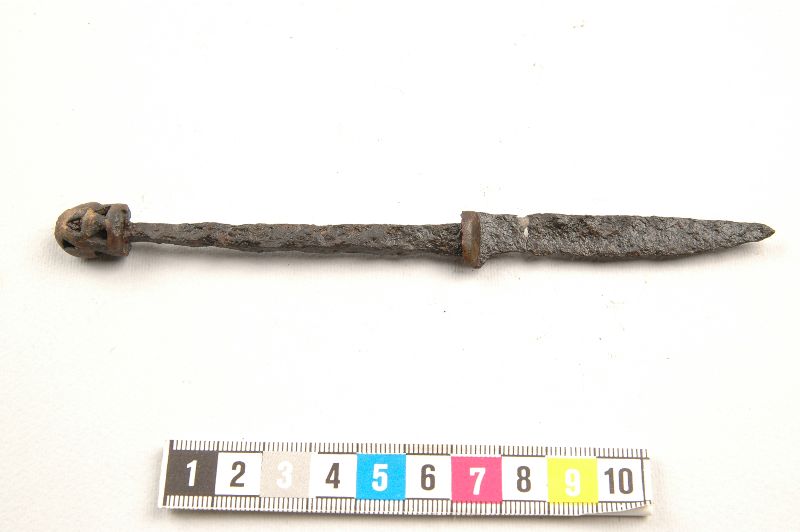| Author |
Message |
Johan Gemvik

|
 Posted: Tue 15 May, 2012 2:41 pm Post subject: 3D models of a sweet viking age eating / utility knife Posted: Tue 15 May, 2012 2:41 pm Post subject: 3D models of a sweet viking age eating / utility knife |
 |
|
I was playing around with CATIA practicing making advanced surface modeling and got the idea to make a model of this viking age knife find from Mora (in northern Sweden).
Yes, a real Mora knife from viking age. This is one of those knives with a thick back cross section and round handle and I rarely ever see them reconstructed.

http://www.kringla.nu/kringla/objekt?text=vik...ect/839539
http://mis.historiska.se/mis/sok/bild.asp?uid=331660&g=1
This is the result where you can see what it might have looked like when it was new and I think it looks really sweet.
The dimensions are a bit off, probably the blade should be shorter and have a little less of a drop point, but you get the idea.




In these two photos I played around with the hole sets on the pommel and using a simpler front plate diverging a bit from the actual find.


The model gives you an idea of what the original might have looked like. I'll probably make one of these for my next knifemaking project, I just have to finish the current one first.
"The Dwarf sees farther than the Giant when he has the giant's shoulder to mount on" -Coleridge
|
|
  |
 |
|
Myles Mulkey
|
 Posted: Tue 15 May, 2012 7:18 pm Post subject: Posted: Tue 15 May, 2012 7:18 pm Post subject: |
 |
|
|
Nice job! Really good impression of the thickness of knives from this time. I think you picked a good example to work from. Good work.
|
|
  |
 |
|
Ryan S.
|
 Posted: Tue 15 May, 2012 9:59 pm Post subject: Posted: Tue 15 May, 2012 9:59 pm Post subject: |
 |
|
|
how did you choose the handle material?
|
|
  |
 |
G Ezell
Industry Professional

Location: North Alabama Joined: 22 Dec 2003
Posts: 235
|
 Posted: Wed 16 May, 2012 8:12 pm Post subject: Posted: Wed 16 May, 2012 8:12 pm Post subject: |
 |
|
Very cool! I've used Rhinoceros nurbs modeler quite a bit and found it very useful for visualizing and 'prototypes'.
Are you certain the handle was round in cross-section? I ask because round handles on an edged item are not comfortable to use, and most of the knife handles of the period I have seen cross-sections for are usually oval or tear-drop shaped, as are the vast majority of modern knives of nordic origin...
" I have found that it is very often the case that if you state some absolute rule of history, there will be an example, however extremely unusual, to break it."
Gabriel Lebec
https://www.facebook.com/relicforge
|
|
   |
 |
Johan Gemvik

|
 Posted: Fri 18 May, 2012 5:22 pm Post subject: Posted: Fri 18 May, 2012 5:22 pm Post subject: |
 |
|
| G Ezell wrote: | | Are you certain the handle was round in cross-section? I ask because round handles on an edged item are not comfortable to use, and most of the knife handles of the period I have seen cross-sections for are usually oval or tear-drop shaped, as are the vast majority of modern knives of nordic origin... |
No wood left on this one so we can't know anything for sure really, though if the handle was oval or teardrop shaped as we see a lot then the fittings would most likely be too like they are there.
I'm calling it a decent elementary guess, best anyone can do really, and if anyone feels like making one where the wood bulges out or is cut in at the middle that works for me too.
Of course this particular knife could have had any sort of handle in between the end fittings, ribbing, bulges, grooves and so on, but both the front and back fittings are round which gives a good indication the organic material handle would have followed the same lines, especially if my theory about it being primarily used for food or fine crafts.
There are several finds of what the archaeologists dub viking eating knives with more plain round cross section handles intact. Two separate finds are listed and photos presented in the "From Viking to Crusader" book and I've seen at least one IRL at a museum.
Yes, they seem impractical for use to splint and whittle wood, or rend meat like it's much bigger cousins. But these are tiny knives anyway not fit for heavy work. I see cutlery as well as surgical and precision point crafts work possibilities and maybe for that type of use a round handle is better after all.
"The Dwarf sees farther than the Giant when he has the giant's shoulder to mount on" -Coleridge
|
|
  |
 |
|
|

